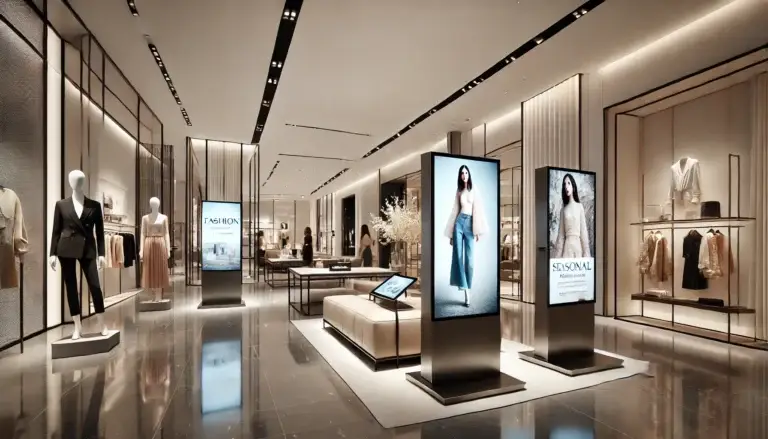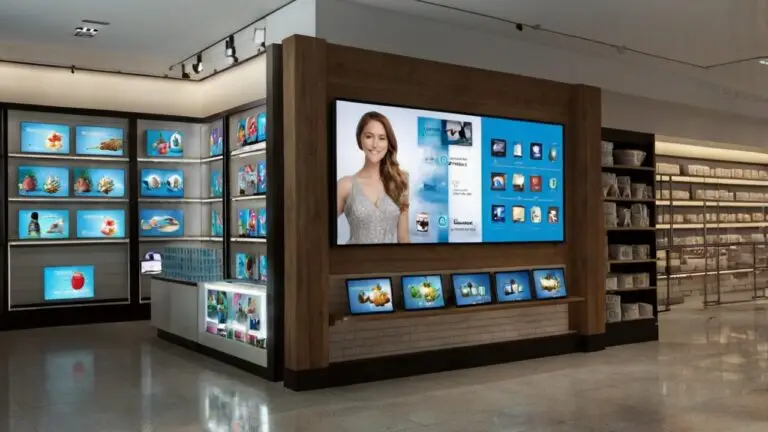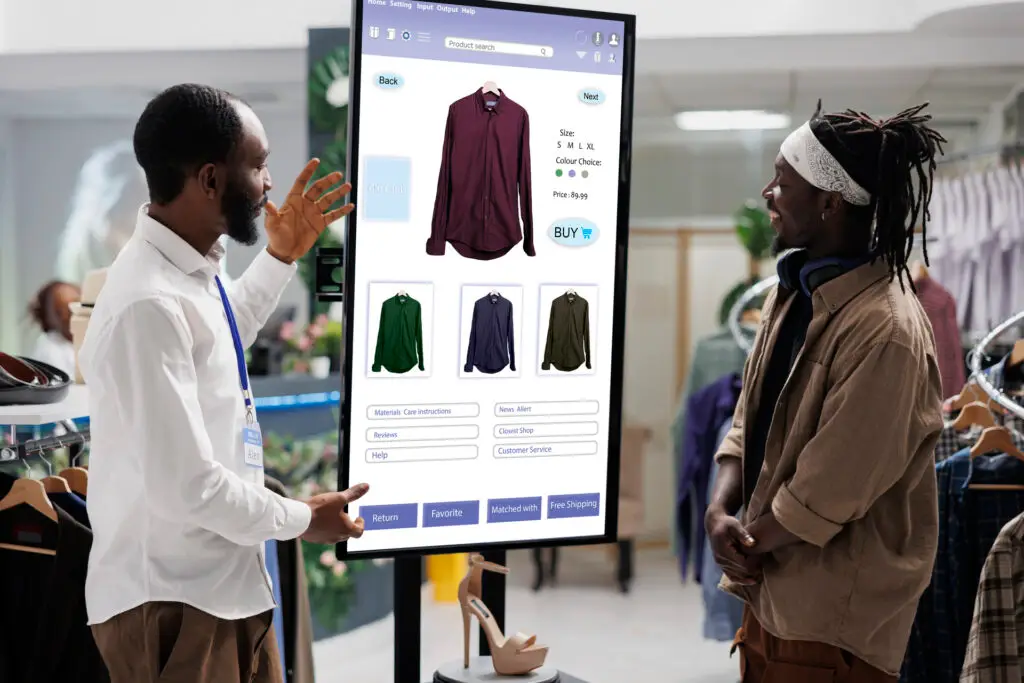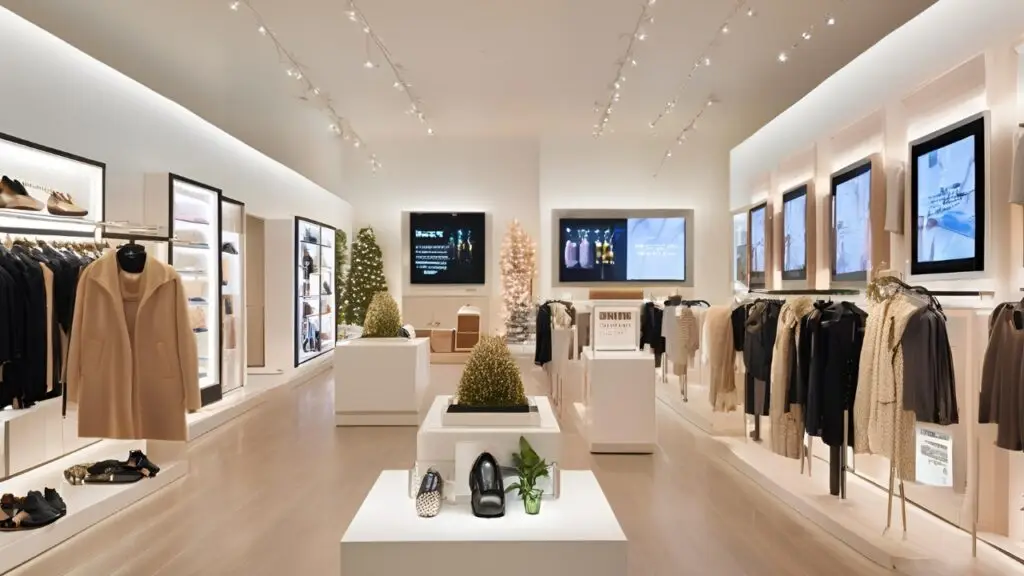In retail, customer experience isn’t just important. It’s everything. The smartest retailers know that retail digital signage isn’t just a nice-to-have, it’s the engine powering modern in-store engagement.
They’re not just putting up screens. They’re transforming physical stores into interactive spaces that feel as seamless as shopping online.
Video walls grab attention and create immersive brand moments
Wayfinding kiosks actually help shoppers find what they need without frustration
AI-powered displays serve up personalized promotions based on shopper behavior, time of day, or location
This is how brick-and-mortar fights back. It blends the convenience of e-commerce with the tactile, human connection of in-store shopping.
What is Retail Digital Signage?
Retail digital signage adds a powerful screen-based layer to your store’s environment. These displays do more than just look good. They promote products, share live updates, and capture shopper attention in real time.
The goal is simple: make the in-store experience feel smarter, more personalized, and in line with what today’s customers expect the moment they walk in.
Core Features of Retail Digital Signage
Dynamic Content
Show updated videos, images, pricing, or promos that shift throughout the day. Keep your messaging fresh and relevant.Interactive Experiences
Use touchscreens, product finders, or QR codes to give shoppers a deeper, more engaging way to explore your offerings.Data-Driven Personalization
Deliver targeted content based on customer demographics, purchase history, or local trends. Tailored messaging makes the experience feel curated, not generic.



Why Retail Digital Signage is a Game-Changer
Digital signage isn’t just a sleek upgrade. It’s a strategic tool that boosts sales, improves the shopper experience, and keeps your messaging consistent across every touchpoint.
Screens That Sell
Static signs can’t compete. Digital displays catch eyes with motion, vibrant visuals, and real-time updates. Whether it’s a flash promo or a new product launch, your message gets noticed—and remembered.
Design That Elevates the Entire Store
Great signage does more than inform. It transforms the space. From animated window displays to looping content at checkout, screens create a modern, energized atmosphere that brings your brand to life.
Personalization That Actually Performs
Customers expect tailored experiences. Smart signage delivers them by pulling data from your POS, loyalty programs, or foot traffic trends. The result? Promotions and product suggestions that feel relevant and timely for every shopper.
Omnichannel Alignment in Action
Your brand message should be seamless, whether customers are on your site, your app, or in your store. Digital signage bridges that gap by reinforcing campaigns, offers, and visuals in a way that feels cohesive and connected.
Agile, Scalable, and Always On Time
No more printing delays or overnight shipping. With digital signage, you can update content across hundreds of stores in minutes. It’s faster, cleaner, and more cost-effective—without sacrificing quality or impact.

Benefits of Retail Digital Signage
Digital signage isn’t just about putting displays on walls. It’s about creating smarter, more engaging stores that respond to how people actually shop. Here’s how it delivers real impact:
Boosts Engagement
Show live promotions, product features, and bold visuals that grab attention and keep customers moving through the store.
Simplifies Navigation
Use interactive maps and wayfinding screens to help shoppers find what they need—fast and frustration-free.
Delivers Personalization
Tap into real-time data to tailor messages by location, time of day, or shopping behavior. The result feels personal, not generic.
Drives Promotions
Spotlight flash sales, new arrivals, and event teasers where they’re most likely to be seen—and acted on.
Reduces Wait-Time Fatigue
Entertain customers at checkout or service counters with content that makes waiting feel shorter and more pleasant.
Connects Channels
Align in-store messaging with your website, mobile app, and digital ads to create a seamless customer journey.
The takeaway:
Digital signage turns brick-and-mortar stores into dynamic spaces that feel modern, memorable, and connected to the way people shop today.

10 Stats That Prove Retail Digital Signage Works
If you’re still wondering whether digital signage belongs in your store strategy, these numbers speak for themselves:
46% boost in customer satisfaction
Stores using digital signage report nearly half higher satisfaction rates compared to those relying only on static signs.
(Digital Signage Today, 2024)400% more views than static displays
Digital screens grab attention—quadrupling visibility on the retail floor.
(Intel Retail Study, 2024)31.8% average sales lift
Products featured on digital signage significantly outperform those without digital promotion.
(Retail Customer Experience Survey, 2025)76% of shoppers enter because of digital signage
Eye-catching displays aren’t just for show. They drive foot traffic.
(Statista Retail Technology Report, 2024)5x more engagement from interactive kiosks
Touchscreens and product finders pull shoppers in, with average interaction times over 2.5 minutes.
(Retail Technology Consortium, 2024)68% say digital signage influences buying decisions
Shoppers are more likely to act when messaging is visual, timely, and in the moment.
(DOOH Consumer Behavior Study, 2025)25–30% drop in perceived wait times
Digital menu boards and content loops make the checkout experience smoother and faster.
(Journal of Retail Technology, 2024)33% more impulse buys at point-of-purchase
Digital signage placed near registers or displays drives unplanned sales.
(Retail Systems Research, 2025)22% higher conversion with AI-powered signage
Personalized, real-time content leads to more purchases.
(McKinsey Retail Analytics, 2024)ROI in just 9 to 12 months
Thanks to lower hardware costs and stronger performance, the return on digital signage is faster than ever.
(Digital Signage Federation, 2025)
How to Implement Retail Digital Signage
Rolling out digital signage in retail isn’t just about installing screens. It’s about building a strategy that aligns with your business goals and enhances the customer experience. Here’s a step-by-step approach to doing it right:
Set Clear Objectives
Start with a purpose. Define what success looks like.
Are you aiming to increase sales?
Improve brand perception?
Simplify the customer journey?
Your goals will guide every decision that follows.
Choose the Right Technology
Invest in hardware and software that match your needs today—and can grow with you tomorrow.
Media Players: Go for reliable, commercial-grade devices that can run content smoothly all day.
Software: Pick a content management system that’s easy to use, flexible, and scalable.
Displays: Screen size, resolution, brightness, and placement all affect how content performs.
Prioritize Strong Content
Content is what makes the screen matter. Focus on what will engage your audience.
Use high-quality visuals and keep messaging clear and concise.
Refresh content often to reflect current promotions, events, or seasons.
Place Displays Strategically
Location is everything.
Position signage where it will have the most impact—entrances, product aisles, checkout lines, or window displays.
Align with the natural flow of traffic in your store.
Monitor and Optimize Performance
Track what’s working—and what’s not.
Use analytics to measure engagement, influence on sales, and shopper behavior.
Adjust content and placement based on data to maximize results.
Real Signage Success Starts Here!
Basic Challenges and Simple Solutions
Implementing retail displays comes with a few hurdles—but with the right strategies, these challenges become opportunities to optimize, scale, and differentiate your in-store experience.
1. High Initial Investment
Smart Strategy:
Start small, scale smart
Launch in high-impact zones like entrances and checkout areas. Expand based on performance and ROI.Lease hardware
Reduce upfront costs with leasing options while keeping hardware current and serviceable.Focus on ROI
Factor in cost savings from reduced print materials, higher sales lift, and greater operational efficiency.Monetize your screens
Partner with vendors to display branded content and turn your network into a revenue channel.
2. Content Management Complexity
Smart Strategy:
Go cloud-based
Use centralized platforms to update content across all locations from one dashboard.Make it dynamic
Connect with POS, pricing, and inventory systems to automate real-time content updates.Build a content library
Create brand-approved templates that store teams can quickly customize.Schedule ahead
Use advanced scheduling tools to automate seasonal campaigns, promos, and product rollouts.
3. Staff Training Needs
Smart Strategy:
Train by role
Tailor training to each team’s needs—marketing, store ops, IT, and frontline associates.Use video
Short, focused video tutorials beat lengthy manuals and help with onboarding and retention.Nominate in-store champions
Equip tech-savvy staff to lead the way and support others on-site.Choose simple systems
Select platforms with intuitive interfaces that require minimal training to use effectively.
4. Technical Headaches
Smart Strategy:
Plan for bandwidth
Ensure your infrastructure can support streaming content and remote updates without disruption.Use remote monitoring
Get alerts before customers notice a screen is down, and fix issues proactively.Test before you launch
Run full integration tests with your existing systems to avoid surprises at rollout.
The Bottom Line
Top-performing retailers don’t just work around these challenges—they turn them into competitive advantages. With the right setup, your digital signage strategy can elevate the shopping experience, drive revenue, and scale with confidence.

Measuring the Impact In Your Retail Store
Measuring success goes beyond whether your screens are running. Use these key metrics to track performance across three core areas: system health, shopper engagement, and business impact.
Technical Metrics
Monitor system stability, reliability, and operational efficiency.
📊 System Uptime: _____%
🔄 Content Update Success Rate: _____%
⚡ Power Efficiency Rating: _____%
🌡️ Display Temperature Status: Normal / Warning
🔌 Network Connectivity Strength: Strong / Medium / Weak
Engagement Metrics
Gauge how well your signage captures attention and drives interaction.
👥 Average Daily Views: _____
⏱️ Average Dwell Time: _____ seconds
🔄 Interaction Rate (for touchscreens/kiosks): _____%
📱 QR Code Scans: _____
🎯 Click-Through Rate (for shoppable content or links): _____%
Business Impact
Tie signage performance to real retail results.
📈 Sales Lift on Promoted Products: %
💰 Revenue Attributed to Signage Campaigns: $
🛒 Conversion Rate Increase: _____%
⭐ Customer Satisfaction Score: _____ / 5
💵 Return on Investment (ROI): _____%
Trends in Digital Signage For Retail
The retail signage game evolves fast. What wowed customers last year may already be standard today. If you’re not planning ahead, you’re falling behind. Here’s where the innovation curve is heading—and what your competitors are likely gearing up to implement next.
1. AI-Powered Personalization
Artificial Intelligence is moving from the back office to the front line. Smart displays now adjust content in real time based on shopper behavior, demographics, time of day, or even weather. Expect more product recommendations, tailored promotions, and localized offers—served instantly and intuitively.
2. Augmented Reality Integration
AR-enabled signage turns browsing into a virtual try-before-you-buy experience. Shoppers can visualize furniture in their homes, test out makeup shades, or explore product features through their phones or in-store screens. It’s immersive, practical, and memorable.
3. Programmatic Advertising
What used to be reserved for online ads is now reshaping in-store media. Programmatic platforms optimize when and where branded content appears—maximizing relevance and revenue. Retailers and brands both win with more precise targeting and data-driven placements.
4. Sustainable Signage Solutions
Green signage is no longer optional. Energy-efficient displays, E-paper, remote content management, and recyclable hardware are now top priorities. Retailers are also exploring leasing and hardware-as-a-service models to reduce waste and support circular design.
5. Omnichannel Synchronization
Digital signage is becoming a fully integrated part of the customer journey. Screens are syncing with apps, loyalty platforms, e-commerce systems, and in-store sensors to ensure messaging stays consistent—whether the customer is online, in-store, or somewhere in between.
Bottom Line
Digital signage isn’t standing still. The most successful retailers are using it not just to keep up—but to lead. If your signage strategy isn’t evolving, it’s falling behind.
Retail Media Networks and Digital Signage
Retail Media Networks are redefining the role of digital signage—from an engagement tool to a full-fledged monetization channel. By opening up in-store screens to brand advertisers, retailers can unlock new revenue streams while delivering personalized, high-value content to shoppers.
Here’s how it works:
Brands pay to reach customers directly at the point of decision, whether it’s a targeted ad at the checkout counter or a timely product promo in the snack aisle.
Retailers retain control over screen real estate and shopper experience, while leveraging data to serve the right message at the right moment.
Shoppers benefit from relevant, context-aware promotions that actually enhance their journey, not interrupt it.
Done right, RMNs are a win-win-win—for retailers, brands, and customers alike.

Conclusions
Retail digital signage has moved far beyond passive displays. It’s now a core part of the in-store strategy. Shaping experiences, influencing buying decisions, and driving measurable results.
By combining smart technology with creative content, digital signage transforms retail spaces into dynamic environments that engage shoppers, streamline communication, and fuel growth.
As the industry evolves, retailers who invest in digital signage aren’t just keeping up. They’re leading the way, delivering modern, memorable shopping experiences that build loyalty and set their brand apart.
Take Action Today
Ready to enhance your store? Contact me for expert guidance and tailored solutions that align with your goals.
Learn more in my full Retail Digital Signage insights archive
FAQ
How can digital signage benefit retail businesses?
Digital signage enhances customer engagement by showcasing promotions, product information, and seasonal offers in an eye-catching way. It also helps create a modern shopping experience by integrating interactivity, such as touchscreens for browsing inventory or personalized recommendations.
Is digital signage suitable for small retail stores?
Yes, digital signage is scalable and can be tailored to the needs of small stores. Even a single screen displaying rotating offers or announcements can increase customer engagement and provide a competitive edge over traditional static signage.
Can retail store digital signage be updated in real time?
Absolutely! With a cloud-based content management system (CMS), retailers can update their signage instantly. This allows for quick adjustments, such as flash sales, new arrivals, or time-sensitive promotions, keeping content fresh and relevant.


